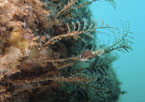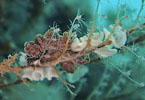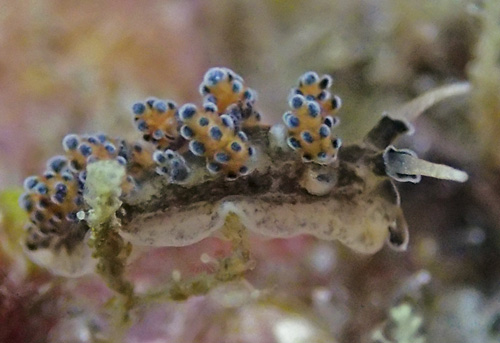| Home |
| Acknowledgments |
| Conventions |
| Glossary |
| Maps |
| References |
| Links |
| Articles |
| Thumbnails |
| Species
list |
| Family |
| Next
species |
Additional Photos

on food hydroid

with egg masses

Doto sp. #2

| Maximum size: about 5 mm. Identification: This is a small species with evenly tuberculate cerata. The body is cream liberally blotched with black. The digestive gland showing through the cerata is orange to dusky pink while the tubercles have black cores. The tubercles are frosted with white (with a few denser white spots). The rhinophore tips are white with a few opaque white spots and the rhinophore sheaths are black with white edges. Natural history: Doto sp. #2 is known from at least ten animals found on what appears to be Pennaria disticha in a heavily shaded micro-habitat at a protected to moderately protected harbor location. They were at a depth of less than 1 m (3 ft). (Hai Van On, pers. com.) It probably feeds on its host and lays a white, flattened, irregularly convoluted egg mass. Pairs of animals coil around the host hydroid when laying eggs. (Note 1). Distribution: Big Island: possibly known from Indonesia. Taxonomic notes: It was first recorded in Hawaii from Kawaihae Harbor, Big Island by Hai Van On on April 28, 2019. (Note 2) Photo: Hai Van On: about 5 mm: Kawaihae Harbor, Big Island; April 28, 2019. Observations and comments: Note 1: The presence of paired animals with typical Doto egg masses on what appears to be Pennaria disticha suggests that it feeds on that species. Also, the presence of "dark-zone" octocoral polyps in some of the uncropped photos suggests a heavily shaded micro-habitat. Note 2: This species appears close to "Doto sp. 5" in Gosliner, et. al. (2018). However, it differs from it in the color of its rhinophores and its host hydroid. It seems closer to the 15 mm Indonesian animal illustrated as "Doto sp. 18" at Seaslug World. The white line on the edge of the rhinophore sheath is less well defined in the Indonesian animal but that difference could be due to ontogeny. Based on its host hydroid, there's also some possibility that it's introduced (if its host is actually P. disticha). |
| Thumbnails |
Species
list |
Family | Next species | Top |